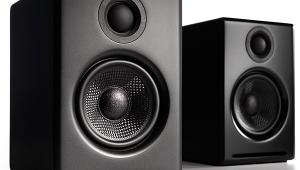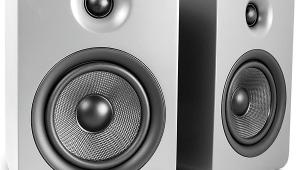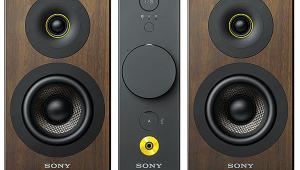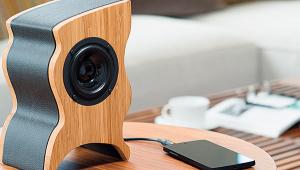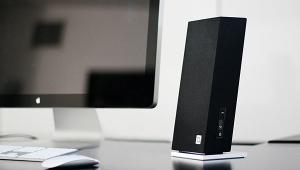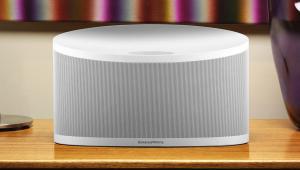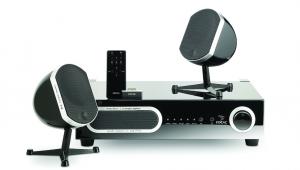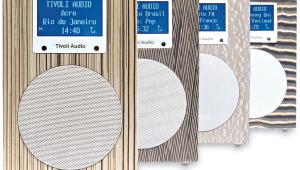Power to the Speakers: Three New Active Desktop Systems Page 3
Audioengine 5+ ($399/pair; stands $34/pair, audioengineusa.com)
Audioengine is a 21st-century brand that sells clever desktop audio designs direct-to-consumer, as well as via online (and select brick-and-mortar) retailers. The firm’s latest powered-speaker flagship, the Audioengine 5+, is a slightly larger and more powerful redesign of the original Audioengine 5 model, but it’s otherwise very similar: a handsomely plain, grille-less two-way that’s on the larger side of desktop-ability but still fairly acceptable.
Audioengine puts all the amps and fixins’ within the right speaker, so all the controls and hookups are on its front panel; the left-hand unit gets only a nice metal multi-way passive-input pair. The right, then, carries a corresponding left-output pair, a fairly large heatsink (for the internal amplifiers), and line inputs on both 1/8th-inch stereo and a pair of RCA jacks; a pass-thru RCA stereo output permits daisy-chaining multiples. Cleverly, there is also a power-only USB port, so you can charge your iWhatever (or Zune!) to while it’s jacked into the 5+’s — thoughtful touch.
On the ergo front, I have no complaints. The only control is a single, continuously variable wheel on the right speaker’s front that adjusts master volume, and toggles the 5+ into a ramp-up/down “energy-saving sleep” mode when pressed. Audioengine’s design is the only one of our trio to include a remote control (though it’s not really necessary in a desktop setup), in the form of a simple, card-type remote with volume up/down, sleep, and mute keys (the remote’s mute button is the only quick-mute available).
Sonically, the 5+ is impressively accurate through the vocal regions — I heard no telltale “honk” or “hoo” effects imposed on male or female voices — while delivering a beguilingly warm balance. Warm, but not overly so: treble and high-treble “air” were still eminently evident and satisfyingly extended, but the Audioengines did not have the bite of attack on, for example, subtler brass accents or cymbal snicks, that many speakers today do. (I’m not saying this is necessarily bad — the 5+ clearly has steady output extending to, or nearly to 20 kHz — just that its top couple octaves seem to exhibit a mild down-tilt in response. And I’m betting it’s no accident; once, all speakers were like this by design, since the top half-octave of LPs and tapes had about as much hash and hiss as actual content. MP3, anyone?)
Bass performance was nothing short of remarkable —true in varying degree of all three speakers in these pages — delivering amply convincing bass on almost any pop or jazz material. The very lowest musical fourth or so of bass guitar/viol sacrifices a bit of heft, but the Audioengines’ ability to deliver a solid, rocking rhythm section just about intact was downright impressive.
Perhaps the 5+’s most dramatic aural attribute, though, was its stereo imaging. In in-the-room listening the Audioengines threw out a rounded, rock-steady sound stage that hung between and extended fully to the two speakers. When the speakers were used in a desktop array this was, if anything, more dramatic, placing centered soloists smack-dab “on” the computer’s monitor with ghostly believability.
For whatever reason, the 5+’s vertical dispersion is quite narrow, and while the 5+’s do have a nice padded bottom to protect surfaces there’s no tiltable desk stand included (a stand is available separately). During in-room listening the stand up/sit down test yielded substantial changes in treble balance, while in desktop use this was of course even more dramatic (because ear-to-speaker distance is only 25 inches or so). Thus, on the desktop, I found placing stick-on rubber feet in front only, inducing an up-tilt of perhaps 20 degrees, important to get the 5+’s best balance.
And the Audioengines can play loud. Not quite loud enough to fill my large (16x22x8 feet) studio with party-time tunes, but far louder in desktop use than I — or most reasonable beings — would ask. As I pushed volume towards (though short of) the limit at which the 5+es audibly harshened, they became a bit “tubbier” on the bottom, while not stripping off bass content dramatically. That said, the speakers could be made to sound obviously clipped and distorted when sent a high-volume-setting signal from an audio component with a decent output (1.5 volts or greater) — something that was true to some degree of all three systems. (It’s an interface-sensitivity problem: even though an active speaker takes many potential problems out of the equation, the designers still don’t know if you’ll be driving their speakers with a ¼-volt, relatively high-impedance headphone signal from your last-century Rio MP3 player, or (as I did) a 4-volts-peak preamp output. Another argument for the closed-system loop notions of the late Steve Jobs, may he rest peacefully.
